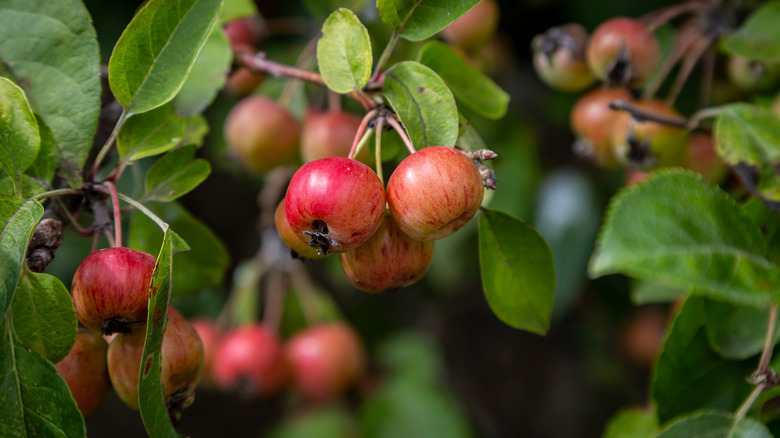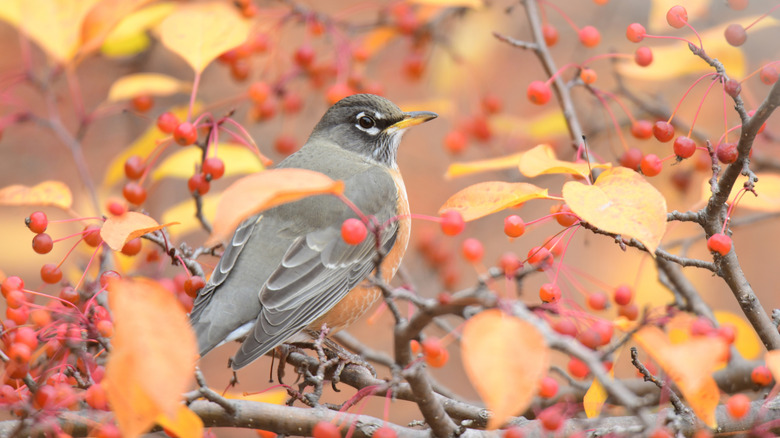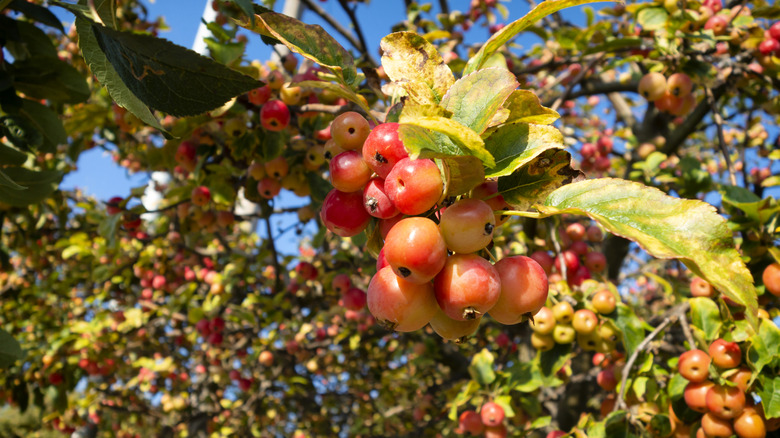Fruiting Crabapples Are Low Maintenance, But This Downside Means A Bit Of Extra Care
Crabapple trees (Malus spp.) are frequently grown for their showy spring buds and blossoms in colorful shades of pink. They also produce small, tart apples in the fall, making them a food source for both wildlife and humans. However, the fruits tend to start falling to the ground in early winter and make a bit of a mess, especially in spots with high foot traffic, so having some strategies for preventing or dealing with this problem can be helpful.
There are a few ways to deal with the potential for crabapple trees being somewhat messy. This ranges from choosing certain varieties that are less likely to drop fruit, to locating trees in less problematic areas. You can also try physical strategies such as pruning, using a ground covering to protect your sidewalk or driveway, or shaking the tree to harvest some of the apples before they can make a mess.
There are many types of crabapple trees you can grow in your yard, with variations in fruits and blossom color. Depending on the variety, crabapple fruits may be tiny (smaller than a dime) or fairly large (up to 2 inches across), and the larger fruits are generally considered best for making crabapple jelly. The tiny fruits are the most attractive to birds, who also enjoy perching in the graceful flowering branches. Small rodents like squirrels and chipmunks will also feed on the fallen fruits. Choosing a good location for a crabapple tree can be easier than other trees since these flowering and fruiting trees will thrive in clay soil, and many varieties are fairly disease-resistant and low maintenance.
Crabapple trees through the seasons
Crabapple trees provide beauty and utility through four seasons. The showy, sweet-smelling blossoms are delightful. In summer, the trees leaf out and provide shelter for birds. Then in autumn, the fruits come, providing tasty snacks for crabapple-loving robins, cedar waxwings, finches, bluebirds, and cardinals. Crabapples often remain on the trees through the colder months, providing a bird-friendly winter habitat in your backyard.
If you're considering planting crabapple trees, think about the size of the fruits. Unless you want to make jam or preserves, a smaller fruiting variety is usually best to limit the mess. Gardeners find that these crabapples are less likely to fall from the tree and are more likely to be eaten by birds (who may peck at larger crabapples but can't eat them due to their size). These smaller varieties of crabapple are known as 'clean crabapples' and are hardy in USDA Zones 4-8. They include 'Adams,' 'David,' 'Indian Summer,' 'Lancelot,' 'Firebird,' and many others.
Be sure to plant new crabapple trees away from sidewalks and driveways if possible. This reduces the potential of fallen fruit making a sticky mess underfoot. Also, choose a spot where you can observe the tree through the seasons and witness the lovely blossom show in spring and the birds that will visit all year round. Certain crabapple varieties provide excellent food sources for birds in late fall (like 'Profusion,' 'Prairifire,' and 'Calocarpa') and even well into winter, including the aptly named 'Birdland' and 'Bob White,' which produce handsome golden apples. There's even a variety of crabapple called 'Big Deer' with fruits that stay on the tree through January that deer find irresistible.
Keeping your crabapple tree from making a mess
If you're reading this, chances are you either already have crabapple trees in your yard or are thinking about planting one. If you already have a crabapple tree that's too mature to move, and your tree dropping fruit is a problem, here's one thing you can try: prune back any branches or limbs that overhang walkways. This will lessen the number of crabapples that will make a mess.
You can also try putting down a cloth or tarp during the season when the apples ripen and fall, to prevent them from sticking to your sidewalk or driveway. Shaking the tree when the apples become ripe and catching them over a tarp or blanket lets you get a head start on the crabapple falling season. You can then use the apples for eating or cooking, or put them somewhere for wildlife to eat them, like deer, squirrels, or chipmunks.
It may also be worth considering a fruitless variety of crabapple as an alternative to fruit-producing trees. 'Spring Snow' is one such cultivar, and produces masses of fragrant, snowy white blossoms in spring. Another non-fruiting variety is 'Prairie Rose,' which has showy red-pink blossoms that are also fragrant. These two varieties allow you to have ornamental blossoming trees without the messy fruit.


